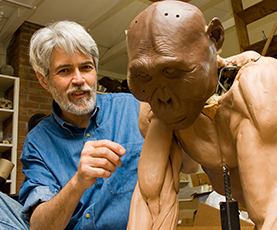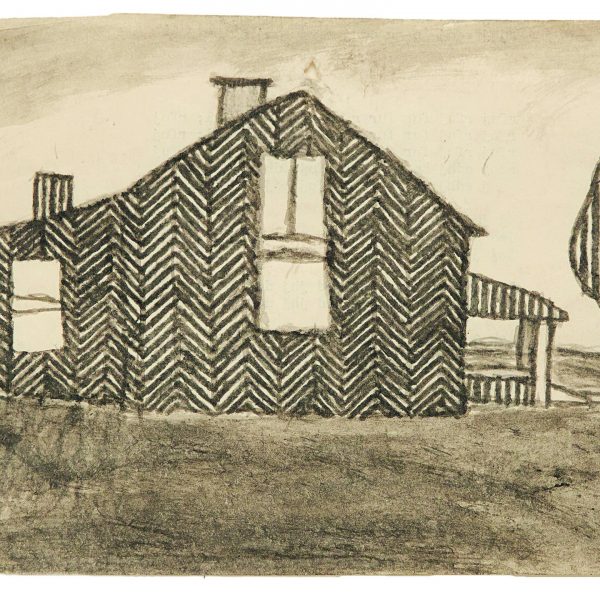Animating Anthro with Art: An interview with Paleo-Artist John Gurche
When you see dug-up primate bones at a natural history museum or in the science classroom, it can be difficult to fully grasp the notion that they belonged to beings that lived and breathed millennia ago. Even more difficult is to visualize what now extinct or evolved animals actually looked like to our human eyes. Paleo-artist John Gurche helps us overcome both challenges with his reconstructions of primates that allow us to see not only what they looked like but also appreciate that these creatures were thinking, feeling beings as well. Through lucid prose and visually stunning images, Gurche chronicles the challenges and successes of the reconstruction process in his book Shaping Humanity: How Science, Art, and Imagination Help Us Understand Our Origins. YUP presents a Q&A with Gurche to learn more about his experience.
Yale University Press: What do you hope readers will take away from their experience of encountering Shaping Humanity?
John Gurche: When I began this book, I thought it would be pretty much a nuts and bolts book, a little like a paleo-CSI. I would explain how we look at clues in the fossil bones to learn about the lives and appearances of ancient hominins. But working with these ancestors, you make such powerful connections with them, and these connections, a bit surreal at times, began creeping into the writing. So yes, I hope readers will take away information about how we reconstruct ancient humans, but also, I hope to have captured some of the ancestral connection itself, and I hope to transmit this to readers as well. Carl Sagan was big on promoting the “cosmic connection,” a way of seeing our lives and our world within the larger context of space. The ancestral connection is a way of seeing ourselves and our time within the larger context of our evolutionary history. I find this tremendously life-enriching and I hope readers will too.
YUP: Which of the hominid ancestors you depict for the book is your favorite? Which was the hardest to execute? The easiest? The most controversial (and why…)
JG: My favorite ancestor would be the one I am working on at the moment. Then I start the next one and that becomes my favorite.
The hardest issues in reconstruction of extinct hominins are those relating to features which do not leave bony clues. Eyebrows. Lip coloration. The uniquely human configuration of fatty tissue in the cheek. As it happens, many of these have a role in visual communication in humans. But since they leave no trace in the bones, you are stuck with trying to guess at their timing in human evolution. So the hardest reconstructions are probably those roughly in the late middle of the human career – early species of Homo, meaning habilis, rudolfensis and erectus, because in these forms you have hints that their communication systems are becoming more sophisticated: brain asymmetries that may relate to language ability, suggested by casts of the inside of their skulls; and cranial bases that are beginning to flex, indicating to some that the vocal tract is changing. So it is tempting to think that maybe some of the features with a role in visual communication are beginning to appear as well. But we just don’t know. I just have to talk to the experts and make my best guess, and that bothers me a little.

John Gurche, Credit Julie Prisloe
YUP: When you are close to completing one of your sculptures or reconstructions, what are the most exciting moments? The most frustrating? The most inspiring?
JG: The most inspiring and exciting (and also the weirdest) moments are when you find yourself responding to your sculpture as if it were a living being. Maybe you are taking notes on the reconstruction or working out some calculations, and you look up to find the thing watching you. Rationally you know it’s only plaster, clay and plastic. But if communication of the individual as a living being is one of your main goals, you have to overcome this. It’s like writing fiction. If you want to fool others, you first have to fool yourself. So it I want other people to see these creations as living beings, I have to work on them until I begin to see them this way. The most frustrating? Probably getting the eyelashes just right. They have to be perfect.
YUP: Do you ever have “conversations” with your subjects as you are working on them? If you do, what are they like?
JG: I don’t have conversations with these creations. That idea strikes me as a little silly. These beings-in-progress command respect, and speaking to them in the language of my time is asking that our interaction take place on my turf. It’s a refusal to meet them on theirs, which is more interesting anyway.
YUP: What’s your next project?
JG: The leader of the Dmanisi research team has asked me to do reconstructions of the 1.8 million year old Skull 5 individual, just announced last month. This will probably include both a full figure bronze (They have a partial skeleton for this individual.) and a lifelike silicone head reconstruction. We’re now in the process of trying to figure out the funding for this project, maybe by partnering with a museum here. I’m very eager to see what this individual looked like.
YUP: Long hours working with each ancestor sounds like total immersion. After several years of this, has this experience changed the way you view humanity?
JG: Yes. Viewing humanity within the larger context of the tree of life makes you realize how unique the human niche is. Although our closest relatives among the great apes may display some forms of the elements that make up human culture and adaptation, humans take these much further, to a point where the human niche emerges as something entirely different from any seen previously on earth. Some biologists consider humans and their society to represent a new level in life’s organization, so that you have a series: prokaryotic cell, eukaryotic cell, multicellular organism, human society. Each of these levels emerges from a linkage among individuals of the previous level. Humanity represents a new level of linkage among multicellular organisms, where individual humans are linked by culture, especially symbolic behaviors like art and language.
Award-winning paleo-artist John Gurche is artist-in-residence, Museum of the Earth, Paleontological Research Institute, Ithaca, NY. His works have appeared frequently in National Geographic and similar publications and in major natural history museums including the Smithsonian, the American Museum of Natural History, and the Field Museum. Watch a video animation of his work for Shaping Humanity below.
Featured image
“Sahe tchadensis” via Wikimedia Commons




